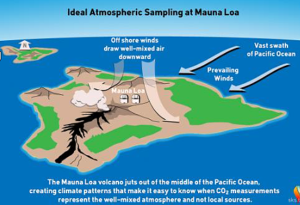7 Decades of Critical Climate Measurements from Hawaii’s Mauna Loa Peak About to End
The Trump administration views science as a threat; so long to Climate truth-telling and cause and effect science.
Denial and blind ignorance as a new national policy in place of valid and revealing science, especially in the areas covering the increasing impacts climate changes on all living things across the planet, well, is not surprising) and by the new Trump administration should come as no surprise, in an escalating change of America’s well vetted policy and setting national priorities. Going backwards to world of 19th century economic and scientific priorities is just not living and in today’s 21st century work, and that is both dumb and dangerous.!
Hawaii’s Mauna Loa Peak, has served as scientific bellwether in measuring rising planetary CO2 emissions now transforming the Earth’s biosphere. Global heating now underway is threatening the present and future of humankind, and most other living things for that matter.
Increasingly, well established science covering the global heating impacts linked to increasing and accumulating fossil emissions within our planet’s biosphere. The production of dangerous planet heating GHG emissions produced by humans is neither a state secret nor subject scientific speculation, it is simple well documented fact of life in the 20th and now 21st century. A fact of modern life all too serious to ignore or be denied. So it makes no sense as national policy that essential science exemplified by the Hawaii’s Mauna Loa monitoring of GHG emissions and supporting real time monitoring and research altogether plays an essential supporting global climate science.
The observatory (near the summit) and is strategically located on the Mauna Loa volcano in Hawaii, and certainly is a globally-valued asset to entire scientific and climate-focused community. The Mauna Loa climate-monitoring site been recording the amount of carbon dioxide or other GHGas levels in the air since 1958,providing the world with the longest continuous record of direct measurements of CO2. Most recent findings from the monitoring site reveal a steadily increasing trend in GHG emissions year-over-year.
 Why Mauna Loa?
Why Mauna Loa?
Early attempts to measure CO2 in the USA and Scandinavia found that the readings varied a lot due to the influence of growing plants and the exhaust from motors. Mauna Loa is ideal because it is so remote from big population centres. Also, on tropical islands at night, the prevailing winds blow from the land out to sea, which effect brings clean, well-mixed Central Pacific air from high in the atmosphere to the observatory. This removes any interference coming from the vegetation lower down on the island.
The closing Mauna Loa monitoring station and three other U.S. sites that track greenhouse gases will no less than disrupt a decades-long record of the planet’s changing atmosphere, which is exactly the intent of this action.
The Mauna Loa climate observatory is part of a global network of stations that monitor the atmosphere. The research performed at these labs lets scientists assess changes over the long term, figure out what caused the changes and make better predictions for extreme events like heat waves, droughts and floods. And the stations can help scientists tell which climate policies are working, which are not, and if global warming is accelerating.
“It’s frankly inconceivable,” said Lisa Graumlich, an emeritus climate scientist at the University of Washington and past president of the American Geophysical Union. People know and understand the “iconic” record, she said.
“A lot of the science we do is incredibly complex, and this record is something that can be grasped by everyone.”
“Why, for relatively little cost, would we want to lose that ability?” Dr. Graumlich said.




Leave a Reply
Join the Community discussion now - your email address will not be published, remains secure and confidential. Mahalo.